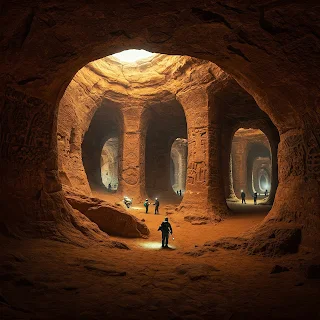In the heart of Africa, deep beneath its ancient landscapes, scientists have discovered a puzzling phenomenon—strange rock tunnels that date back millions of years. These underground structures, which defy conventional geological explanations, have left researchers intrigued and searching for answers. Are they the result of natural forces, ancient organisms, or something entirely unknown? This article explores the findings, theories, and potential implications of this enigmatic discovery.
Discovery of the Rock Tunnels
Where Were They Found?
The tunnels were discovered in multiple locations across Africa, particularly in regions with deep geological history. Researchers from various institutions have identified these formations in South Africa, Namibia, and parts of the Congo Basin. These tunnels appear in sedimentary and metamorphic rock formations, with some penetrating as deep as several meters below the Earth's surface.
Initial Observations
Geologists initially stumbled upon these tunnels while conducting routine surveys on rock formations. Unlike typical underground caves formed by water erosion, these tunnels exhibit distinct characteristics that suggest an unusual origin:
Smooth, rounded interiors resembling artificial boreholes.
Unexplained uniformity in shape and size.
A lack of evidence for water-based erosion processes.
Possible signs of organic or unknown geological activity.
Theories Behind the Strange Tunnels
1. Natural Geological Processes
Some geologists propose that these tunnels were formed through ancient volcanic activity or shifting tectonic plates. However, there are no clear signs of lava flows or fault lines in the immediate vicinity of some tunnels, making this explanation incomplete.
2. Fossilized Burrows of Ancient Creatures
One prevailing theory is that these tunnels were created by prehistoric burrowing organisms. Scientists point to extinct species of giant termites, ancient arthropods, or even early mammals that may have carved out these underground passageways. Fossilized traces of extinct burrowing creatures, similar to today’s mole rats and prehistoric beetles, support this theory.
3. Evidence of Early Human or Hominid Activity?
Another intriguing possibility is that early hominins or even an unknown ancient civilization may have played a role in shaping these tunnels. Some of the formations resemble early mining tunnels, suggesting that our ancestors may have engaged in rudimentary excavation practices for unknown reasons.
4. Extraterrestrial or Unknown Forces
While considered highly speculative, some researchers and enthusiasts have entertained the possibility that these formations could be linked to extraterrestrial activity. This hypothesis stems from the tunnels' strange uniformity and their unusual placement in solid rock.
Scientific Investigations and Dating Methods
Carbon and Isotope Dating
Using radiocarbon and isotope dating, scientists have determined that some of the tunnels date back as far as 1 to 2 million years. This timeline coincides with the early presence of hominins in Africa, raising further questions about potential human involvement.
Microscopic Analysis
Samples collected from the tunnel walls have undergone microscopic analysis to detect any traces of biological activity. Preliminary findings suggest the presence of mineral deposits typically associated with organic decomposition, lending support to the fossilized burrow hypothesis.
Lidar and 3D Mapping
Advanced LiDAR (Light Detection and Ranging) technology has been used to create detailed 3D maps of the tunnel networks. These maps help researchers compare the formations to known burrowing patterns and geological structures.
Implications of the Discovery
Impact on Our Understanding of Ancient Life
If these tunnels were indeed formed by prehistoric organisms, it could reshape our understanding of ancient ecosystems and the role of burrowing creatures in shaping Earth's geology.
Potential Archaeological Significance
Should evidence of early human activity be found, this discovery could provide groundbreaking insights into the lives of early hominins and their interactions with their environment.
Geological Insights
Understanding these tunnels could help scientists refine theories about Earth's geological history, particularly concerning unexplained underground structures found in other parts of the world.
Conclusion
The discovery of million-year-old rock tunnels in Africa presents a fascinating mystery that challenges existing scientific knowledge. Whether formed by ancient life, natural forces, or something yet to be understood, these structures highlight the complexities of Earth's past. Ongoing research and technological advancements may soon provide definitive answers, unlocking a hidden chapter of our planet’s history.
Until then, these strange tunnels remain one of the most intriguing geological puzzles ever uncovered.

No comments:
Post a Comment